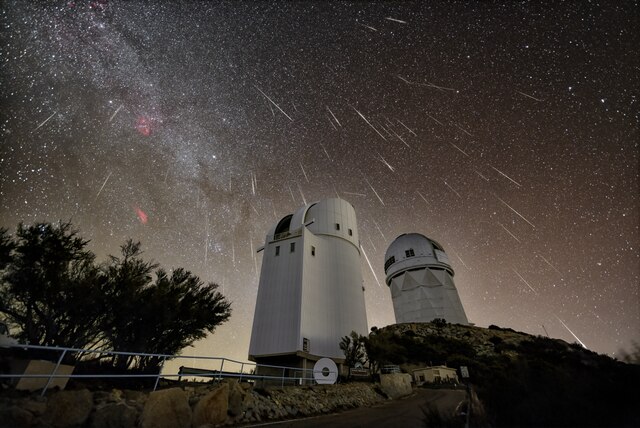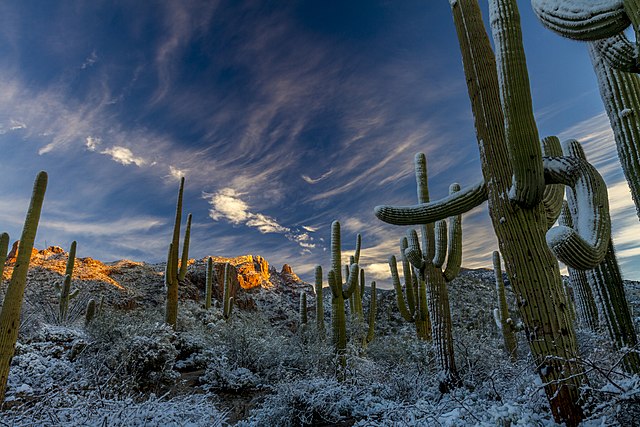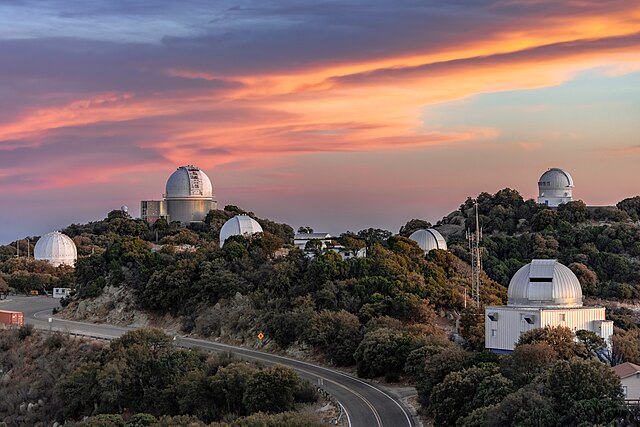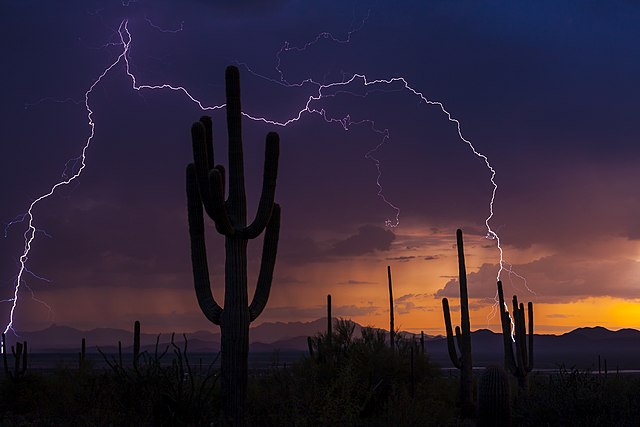Ever wondered what it’s really like to live in one of America’s most unique desert climates? Tucson, Arizona, offers a fascinating weather story that goes far beyond the typical “hot and dry” desert stereotype. This comprehensive guide will take you through everything you need to know about Tucson weather, from its legendary summer heat to its surprising winter charm.
Understanding Tucson’s Unique Desert Climate
Tucson sits in the heart of the Sonoran Desert, creating a climate unlike anywhere else in the United States. The summers are sweltering, the winters are cool and dry, and it is mostly clear year round, with temperatures typically varying from 42°F to 102°F. But there’s so much more to this desert city’s weather story than just numbers on a thermometer.
What makes Tucson’s climate truly special? It’s the dramatic seasonal contrasts that surprise many first-time visitors. You’ll experience scorching summer days that can melt your shoes to the pavement, followed by winter mornings where you might actually need a light jacket. It’s this variety that keeps life interesting in the Old Pueblo.
The city’s elevation of 2,389 feet above sea level plays a crucial role in moderating what could otherwise be an even more extreme desert climate. This elevation provides just enough relief to make the summers bearable and the winters genuinely pleasant.
Geographic Location and Climate Zone Breakdown
Tucson’s weather patterns are shaped by its unique position in the southwestern United States. Located at 32°13′N latitude and 110°58′W longitude, the city sits perfectly positioned to receive influences from both the Sonoran Desert ecosystem and the Mexican monsoon system.
The Sonoran Desert classification means Tucson experiences what meteorologists call a “hot desert climate” or BWh in the Köppen climate classification system. This designation indicates hot summers, mild winters, and very low annual precipitation – though Tucson receives more rainfall than many other desert cities.
Mountain ranges surround Tucson on all sides, creating what’s known as a “basin and range” topography. The Santa Catalina Mountains to the north, the Rincon Mountains to the east, the Santa Rita Mountains to the south, and the Tucson Mountains to the west all influence local weather patterns, creating microclimates throughout the metropolitan area.
Year-Round Temperature Patterns: The Tucson
Experience

Let’s talk about what really matters – how hot does it actually get, and when can you expect relief? Temperature rarely goes below 33°F or above 107°F, which means you’re looking at a comfortable range for most activities throughout the year.
The temperature swings in Tucson can be dramatic on a daily basis, especially during transitional seasons. Don’t be surprised if you start your morning in a light sweater and end your afternoon in shorts and a t-shirt. This daily temperature variation is one of the desert’s defining characteristics.
Winter temperatures rarely require heavy coats, making Tucson a popular destination for “snowbirds” escaping colder northern climates. Summer temperatures, while intense, are often more bearable than humid climates because of the low moisture content in the air.
Spring Weather in Tucson: Desert Bloom Season (March-May)
Spring in Tucson is absolutely magical, and many locals consider it the best time of year. March temperatures typically range from the mid-60s to low 80s Fahrenheit, creating perfect conditions for outdoor activities and desert blooms.
April brings the famous wildflower displays that paint the desert in vibrant colors. Palo verde trees burst into brilliant yellow blooms, while prickly pear cacti show off their stunning flowers. The weather during this time is ideal – warm days perfect for hiking, with cool evenings that invite outdoor dining.
By May, you’ll start feeling the approaching summer heat, with daytime temperatures reaching the 90s. This is still considered prime tourist season because the heat hasn’t become overwhelming, and the desert landscape remains lush from any winter rainfall.
Spring rainfall is typically minimal, which means you can plan outdoor activities with confidence. The low humidity levels make even the warmer days comfortable, and you’ll often experience those perfect “chamber of commerce” days that make Tucson famous.
Summer Heat: Surviving Tucson’s Intense Season (June-August)
Now we’re talking about the season that defines Tucson’s reputation – the summer heat. Summer is characterized by daytime temperatures that exceed 100°F (38°C) and overnight temperatures between 66 and 85°F. But here’s the thing locals know: it’s not as unbearable as you might think.
The key to understanding Tucson summers lies in the phrase “dry heat.” Unlike humid climates where 85°F can feel miserable, Tucson’s low humidity means your body’s natural cooling system (sweating) actually works efficiently. You’ll still feel hot, but you won’t feel that sticky, oppressive sensation common in humid climates.
June is typically the hottest and driest month, often called the “crucible month” by locals. Temperatures regularly soar above 105°F, and the desert landscape takes on an almost lunar appearance. This is when many residents adjust their schedules, doing outdoor activities very early in the morning or late in the evening.
July and August bring a completely different dynamic with the arrival of monsoon season. While temperatures remain high, the increased humidity and afternoon thunderstorms provide both relief and spectacular natural entertainment.
The Famous Monsoon Season: Nature’s Air Conditioning
The official monsoon season in Tucson runs from June 15 to September 30, and it’s one of the most dramatic weather phenomena you’ll ever experience. The word monsoon comes from the Arabic “mausim,” meaning season, and it perfectly describes this predictable shift in weather patterns.
What exactly is a monsoon? It’s a seasonal wind pattern reversal that brings moisture from the Gulf of California and the tropical Pacific up into the Sonoran Desert. The result is afternoon and evening thunderstorms that can be absolutely spectacular – and sometimes dangerous.
Tucson’s average monsoon rainfall is 5.69 inches, which might not sound like much, but in a desert climate, this represents a significant portion of the annual precipitation. These storms don’t just bring rain; they bring lightning shows, dramatic cloud formations, and that distinctive smell of rain on hot desert soil called “petrichor.”
Monsoon storms typically develop in the afternoon as the desert heats up, creating convection currents that lift moisture high into the atmosphere. By evening, you might witness towering cumulonimbus clouds that look like mountains in the sky, followed by intense but brief downpours.
Fall Weather: The Perfect Season (September-November)
If spring is magical, fall in Tucson is absolutely perfect. As monsoon season winds down in September, you’ll experience some of the year’s most pleasant weather. September averages show a high of 93.5°F and low of 67.3°F, making it ideal for resuming outdoor activities.
October is many residents’ favorite month. Daytime temperatures settle into the comfortable 80s, while nighttime temperatures drop into the 50s and 60s. This is prime hiking season, when desert trails that were unbearable in summer become inviting again.
November brings even cooler temperatures and the return of that crisp, clear desert air that makes Tucson famous. You’ll experience brilliant blue skies, comfortable temperatures for any outdoor activity, and the kind of weather that makes you understand why people move to the desert.
Fall is also when many seasonal residents return to Tucson. The combination of perfect weather and the city coming back to life after the slower summer months creates a vibrant atmosphere that defines the Tucson experience.
Winter in the Desert: Mild and Pleasant (December-February)
Winter in Tucson defies expectations. While much of the country battles snow, ice, and freezing temperatures, Tucson enjoys what many consider perfect winter weather. Daytime temperatures typically range from the mid-60s to low 70s, while nighttime temperatures can drop into the 40s.
December and January are the coolest months, and occasionally you might even see frost in low-lying areas or the outlying desert. Snow in Tucson proper is extremely rare, though the surrounding mountains often receive dustings that create stunning contrast against the desert landscape.
February begins the gradual warming trend that leads to spring, with temperatures climbing back toward the 70s and 80s. This is peak tourist season, when visitors from colder climates flock to Tucson to escape winter weather.
Winter nights can actually be quite cool, and longtime residents know to keep warm clothing handy. The desert’s lack of humidity means that once the sun goes down, temperatures can drop quickly – a phenomenon that surprises many first-time visitors.
Rainfall Patterns and Precipitation Throughout the Year

Tucson averages 11.8 inches of precipitation per year, more than most other locations with desert climates. This rainfall comes in two distinct seasons: a brief winter rainy season and the summer monsoon season.
Winter rains typically arrive between December and March, bringing gentle, steady precipitation that can last for days. These storms originate from Pacific weather systems and provide crucial moisture for desert vegetation. While individual storms might not seem impressive, they’re essential for the desert ecosystem.
The summer monsoon season provides the majority of Tucson’s annual rainfall in dramatic, intense bursts. These storms can drop an inch of rain in less than an hour, creating temporary rivers in normally dry washes and spectacular flash flood displays.
Between these two rainy seasons, Tucson can go months without significant precipitation. This creates the classic desert pattern of feast or famine that desert plants and animals have adapted to over millennia.
Extreme Weather Events and Records
Tucson’s weather can occasionally throw some surprises your way. The city has recorded temperatures as high as 117°F and as low as 6°F, though such extremes are rare. More commonly, you might experience dust storms (called “haboobs”) that can reduce visibility to near zero and create dramatic, apocalyptic-looking scenes.
Flash floods during monsoon season represent the most serious weather hazard for Tucson residents and visitors. The desert’s inability to absorb large amounts of water quickly means that even modest rainfall can create dangerous flooding in washes and low-lying areas.
Hail is another monsoon season possibility, though typically not severe. High winds accompanying thunderstorms can down trees and power lines, and lightning strikes are a genuine concern during the stormy season.
Winter freezes are rare but can occur, especially in outlying areas and higher elevations around the city. These events can damage desert vegetation not adapted to freezing temperatures and affect sensitive plants in residential landscapes.
How Climate Change is Affecting Tucson Weather
Recent years have brought noticeable changes to Tucson’s traditional weather patterns. Summers seem to be getting longer and hotter, with 100-degree days extending well into October in some years. The monsoon season has become less predictable, with some years bringing abundant rainfall and others remaining stubbornly dry.
Winter temperatures have also been trending warmer, with fewer truly cold nights and earlier spring warming. These changes are affecting everything from desert ecology to energy consumption patterns throughout the city.
Scientists are monitoring these trends carefully, as they have implications for water resources, urban planning, and the overall livability of desert cities like Tucson. While the desert has always been a land of extremes, the increasing frequency of record-breaking temperatures is notable.
The changing climate also affects the timing of natural events like wildflower blooms, bird migrations, and plant growth cycles, creating a cascade of ecological impacts throughout the Sonoran Desert ecosystem.
Best Times to Visit Tucson Based on Weather
Planning a trip to Tucson? Weather should definitely factor into your timing. The absolute best weather occurs from October through April, with November, December, January, February, and March offering the most consistently pleasant conditions.
If you’re looking for warm but not overwhelming weather, plan your visit for October, November, March, or April. These months offer daytime temperatures perfect for outdoor activities, cool evenings ideal for dining al fresco, and minimal chance of weather-related disruptions.
Winter months (December through February) are perfect if you’re escaping cold weather elsewhere but still want comfortable conditions for sightseeing and outdoor activities. Just pack layers, as mornings and evenings can be surprisingly cool.
Avoid summer months (June through August) unless you’re specifically interested in experiencing monsoon storms or don’t mind extreme heat. If you do visit in summer, plan indoor activities during the hottest parts of the day and save outdoor adventures for very early morning or late evening.
What to Pack for Different Seasons

Packing for Tucson requires understanding the dramatic temperature variations you might experience. Summer visitors need lightweight, breathable clothing, sun protection, and lots of sunscreen. Don’t forget a light jacket for air-conditioned indoor spaces and potential monsoon storms.
Winter visitors should pack layers – t-shirts and shorts for warm afternoons, but sweaters and light jackets for cool mornings and evenings. A warm coat isn’t usually necessary, but having one layer more than you think you’ll need is wise.
Spring and fall visitors have the easiest packing requirements – comfortable casual clothing suitable for mild to warm weather, with perhaps one warm layer for cooler evenings.
Regardless of season, always pack sun protection. The desert sun is intense year-round, and the high elevation means UV exposure is significant even on mild days. Good sunglasses, a hat, and sunscreen are essential any time of year.
Weather Safety Tips for Tucson Residents and Visitors
Desert weather demands respect and preparation. Summer heat safety is paramount – never underestimate how quickly you can become dehydrated or overheated. Carry water, avoid outdoor activities during peak heat hours (typically 10 AM to 6 PM), and recognize the signs of heat exhaustion.
Monsoon season brings different hazards. Never attempt to cross flooded roads – “Turn Around, Don’t Drown” isn’t just a catchy slogan, it’s life-saving advice. Flash floods can occur with startling speed and power.
Lightning safety is crucial during thunderstorms. Tucson receives significant lightning activity during monsoon season, making it dangerous to be outdoors or in exposed areas during storms.
Even in winter, desert conditions require caution. Hypothermia is possible during cold nights, especially if you’re unprepared. The desert’s extreme temperature swings can catch people off guard.
Conclusion
Tucson’s weather is far more complex and interesting than the simple “hot and dry” description often applied to desert climates. From the perfect spring days that showcase desert blooms to the dramatic monsoon storms that provide summer relief, from the comfortable winter months that attract visitors from around the world to the intense summer heat that defines desert living, Tucson offers a weather experience unlike anywhere else.
Understanding these patterns helps you appreciate why Tucson has attracted people for thousands of years. The Tohono O’odham people developed sophisticated ways of living with this climate, and modern residents continue to find ways to thrive in this unique environment.
Whether you’re planning a visit or considering making Tucson your home, knowing what to expect from the weather helps you make the most of everything this remarkable desert city has to offer. From hiking the Santa Catalina Mountains on a perfect October morning to watching lightning illuminate the sky during a summer monsoon, Tucson’s weather provides a backdrop for unforgettable experiences.
The key to enjoying Tucson weather is respect, preparation, and appreciation for the natural cycles that have shaped this landscape for millennia. Once you understand these patterns, you’ll find that each season brings its own special rewards and that the desert climate, far from being monotonous, offers variety and beauty throughout the year.
Frequently Asked Questions
1. How hot does it really get in Tucson during summer?
Summer temperatures in Tucson regularly exceed 100°F, with the hottest days reaching 105-110°F. However, the dry desert air makes these temperatures more tolerable than the same temperatures in humid climates. Most summer days see temperatures between 100-105°F from June through August.
2. Is Tucson too hot to visit in summer?
While summer is challenging, many people do visit Tucson during this time. The key is adjusting your schedule – plan outdoor activities very early in the morning or late in the evening, and embrace indoor attractions during the hottest parts of the day. Monsoon storms in July and August can provide dramatic entertainment and temporary relief.
3. What is monsoon season like in Tucson?
Monsoon season runs from June 15 to September 30 and brings afternoon thunderstorms, lightning displays, and brief but intense rainfall. These storms can be spectacular but also dangerous due to flash flooding and lightning. The monsoons provide about half of Tucson’s annual rainfall and offer relief from the intense pre-monsoon heat.
4. Does it ever snow in Tucson?
Snow is extremely rare in Tucson proper, occurring perhaps once every 10-15 years and usually melting quickly. The surrounding mountains do receive snow during winter months, creating beautiful desert snow contrasts. Frost can occur in outlying areas and higher elevations around the city.
5. What’s the best time of year to visit Tucson for outdoor activities?
The best weather for outdoor activities occurs from October through April, with November through March being ideal. October and April offer warm but not hot days perfect for hiking, while December through February provide mild, pleasant conditions perfect for any outdoor pursuit. Avoid outdoor activities during summer months (June-August) except very early morning or late evening.

